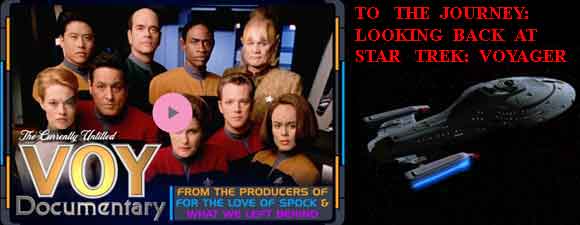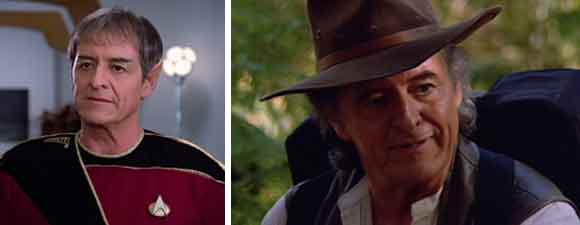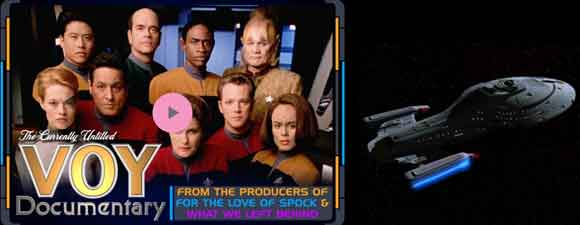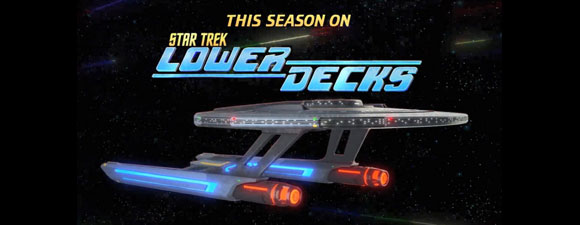Retro Review: Unity
8 min read
unitybanner
Chakotay discovers a planet where former Borg, no longer part of the Collective, have built a home.
Plot Summary: As Chakotay and Ensign Kaplan complete an away mission, they pick up a distress call from someone who identifies their shuttlecraft as a Federation vessel. When Chakotay lands to investigate, unknown assailants shoot at him and Kaplan, causing the ensign’s death and the loss of the shuttle. A badly injured Chakotay learns from a human woman named Riley Frazier that everyone on the planet was abducted and brought there by aliens. Many of the residents fight over limited resources, but she and a group of others have formed a collective that has produced food and wants to reclaim machinery abandoned by the aliens. Chakotay follows Frazier and discovers that the group is made up of former Borg like her, whose sense of unity has fallen away without the link that previously bonded them. He reluctantly agrees to let Frazier’s collective save his life by linking to his mind to strengthen it, after which he and Frazier continue to share mental and physical intimacy. Meanwhile, Voyager discovers a drifting Borg cube and attempts to discover what caused it to become severed from the hive mind. When Voyager reaches Chakotay, Frazier asks Janeway to help her use the Borg cube to relink all former Borg on the planet to enable them to work together again, but although Chakotay tells Janeway that he believes Frazier has no hidden agenda, the captain believes that the danger from a reactivated cube is too great and that she would be violating the wishes of the unlinked individuals on Frazier’s planet. After Chakotay helps Frazier finish repairing the collective’s communications array, she and her group use their link to overpower Chakotay’s mind, forcing him to activate the cube’s power system and relink all the former Borg to Frazier’s collective. The collective then uses the cube’s self-destruct to protect Voyager and apologizes for making Chakotay help them, but Chakotay believes that their idealistic notions about communal living will soon disintegrate into exploitation the way they exploited him.
Analysis: And so the Borg arrive on Voyager, not with a bang – well, not much of a bang – but a whimper. I’m of a double mind about “Unity” because as much as I appreciate the attempt to tell a story about the Borg that isn’t a rehash of all the threats of assimilation and sexy Borg Queen posturing that predominate in the post-First Contact, era, this introduction to the most feared species not only of the Delta Quadrant but indeed of all Star Trek feels anticlimactic. For one thing, it immediately presents the idea of the Borg as vulnerable, which diminishes the ingenuity that Picard’s crew always had to summon, not even to defeat the Borg, which was often impossible, but merely to escape with their lives. Here we see a group of survivors of the Battle of Wolf 359 who have not only recovered their individual personalities and memories, but who share abilities because they were Borg that they wouldn’t possess if they had never experienced assimilation. Rather than being terrified of any sort of mind control as a result of their experiences, like Picard, they are eager to find a way to exploit Borg technology to create a new hive mind, and to assimilate individuals who don’t want to be a part of their collective. The monstrous evil represented by the Borg is simultaneously defanged and spun in a new, more compromised direction. Last week, reviewing “Blood Fever,” I was thinking about how much social understanding of consent in intimate situations has changed since Voyager first aired – how an assault conviction used to depend on proof that someone had said no, while now we understand that the question shouldn’t be limited to whether someone said no but whether someone was unable or unwilling to say yes. Seska’s violation of Chakotay, stealing his gametes, was unquestionably an intimate assault, yet in some ways I find it less problematic than Frazier’s violation of Chakotay, which is mental as well as physical. She literally gets inside his head to turn both his desires and his self-control against him. Whereas Picard never stops fighting the Borg, Chakotay scarcely starts.
Riley Frazier doesn’t present initially as a typical femme fatale, but that’s what she becomes, and it’s so much more aggravating to see in a show from the ’90s than it was in a show from the ’60s. Frazier bats her eyelashes while she suggests hooking Chakotay up to a Borg neural interface and he agrees without a second’s thought about what that might mean from a tactical perspective as well as a personal one. Even though it turns out that none of the colonists are interested in Starfleet secrets – not even the Romulan, who seems as sincerely infatuated with Frazier as she pretends to be Chakotay – he can’t know that until he’s already in a link that could open everything in his mind to them. He doesn’t know about the victory by Picard and Data over the Borg Queen, nor has he seen the defunct Borg cube that Voyager finds and in response immediately goes to red alert. Rather than being willing to lay down his life as so many others have done to protect the Federation from the Borg, he opens himself to their technology, all because an attractive woman assures him that they won’t do anything underhanded. As with “Blood Fever” and various other third season episodes of Voyager, I had hoped that time would temper my feelings and help me to dislike certain aspects less than I once did. I know how the series is going to end, so there’s no point in lamenting things that got screwed up in early seasons, particularly when they led to things I ended up enjoying, like Paris and Torres getting together and Janeway becoming the most effective captain to face the Borg. Yet I often find myself even more disturbed, though I’ve always been able to overlook aspects of the original Star Trek that are artifacts of their era, like the frequently sexist treatment of Uhura and Rand. I suppose it was inevitable that sooner or later the writers would give Chakotay a Gratuitous Love Interest of the Week, but did they have to make him look like such a passive pushover, vulnerable to any long-haired woman who came along and told him what to do?
As with “Blood Fever” too, “Unity” is nicely filmed, with entertaining special effects and visuals not typical for the series on the planet of ruins. The storyline is bolstered by two fine guest performances, Lori Hallier as Riley Frazier and Ivar Brogger as the former Romulan Orum, and Kate Mulgrew gives a lovely turn as well, showing that Janeway can be sympathetic to the ex-Borg yet entirely unwilling to jeopardize her crew or to permit any sort of assimilation to occur. She also manages the delicate balance at the end of appearing angry at the situation in which Chakotay has put the ship without being angry at Chakotay. From the most superficial perspective, “Unity” works well at tying in with recurring villains and offering consistent characterization. I particularly appreciate the flashbacks to older encounters with the Borg, particularly Frazier’s experiences of Wolf 359, a crucial moment for understanding Star Trek as it has developed on every series afterward. Although Starfleet never follows through on the possibility, we’re given a glimpse of how individuals could be weaponized using Borg technology in the name of protection – how easily a Federation that insists on blood tests in the face of a threat from shapeshifters could insist on neural links in the face of the Borg menace. And maybe that’s the problem. Instead of tackling the sorts of ideological questions about freedom of thought under communist leaders that make the original Star Trek so compelling and give us all a good reason to ignore social issues that now seem reactionary, “Unity” opts for those staples of sweeps month, phaser fights and mind control. We see a crewmember and a shuttlecraft lost with no tears shed on the part of anyone, even though Janeway’s always talking about how they’re a family now and they need to preserve what resources they have. From the retro perspective of this review, we don’t learn anything crucial that will recur in later Borg episodes, nor will we ever encounter this particular collective again, which makes “Unity” now seem particularly disposable…memorable only in that it’s our first solid indication that Janeway and Chakotay are never going to return to the relationship they shared in “Resolutions” and appeared briefly to revive in “Future’s End” and “The Q and the Grey.”
It’s popular lore (because one Cinefantastique article says so) that “Unity” was popular when it first aired except among Janeway/Chakotay fans. That must be a comforting story for the series writers to tell themselves – that the mediocre ratings during the crucial ratings month resulted from a bunch of angry women fans who weren’t the target audience, not from what the writers did to the Borg themselves, positing that assimilation provides fewer long-term consequences than previously depicted and suggesting that there’s an even more dangerous foe in the Delta Quadrant. It’s true that I hated “Unity” when it aired because Chakotay never spares a thought for Janeway when he’s with Frazier, but I also feel in retrospect that this is the moment at which he stops being worthy of Janeway. Even if his speech in “Resolutions” about staying by her side and doing everything he can for her is entirely platonic, even if his distress at Q wanting to mate with her and his insistence that he won’t let her go down with the ship are (re)interpreted as simple loyalty, the ease with which he turns over his mind to these ex-Borg, lets Frazier seduce him, invites her to join Voyager’s crew, then surrenders to the voices in his head suggests that he’s not offering Janeway anything besides a no-longer-needed bulwark against Maquis insurrection. Frankly, I’m not sure why he doesn’t want to stay on the planet with the new collective except that it’s necessary for plot purposes for him to go back into space so that he can let Frazier’s people control his actions. This is a man who’s always talking about finding and forming communities, so how does he choose between the friends on Voyager who’ve replaced his tribe and the new friends who’ve invited him into their innermost thoughts? Voyager and the ex-Borg communities have so much in common – former enemies trying to forge a new society with scant resources, onetime Federation science officers trying to create opportunities while faced with overwhelming odds. Why doesn’t Chakotay emphasize those things to Frasier and brag about what Janeway has been able to do as an alternative to needing nonconsensual mind control to form a coalition? Could the writers truly not conceive of a man second in command to a woman who wasn’t also a pushover?






